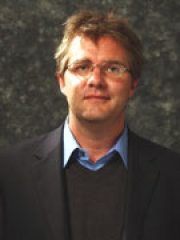Stuart D. Bale received B.A. and Ph.D. degrees from the University of Minnesota in 1989 and 1994, respectively. After three years of postdoctoral work at Queen Mary College, University of London, he came to a research position at the Space Sciences Laboratory (SSL) at Berkeley. He joined the Physics faculty in 2004 and is the Director of SSL. He has held visiting appointments at the Observatoire de Paris, Meudon (Univ. Paris VII), LPCE/CNRS in Orleans, France, the University of Sydney, and Imperial College and Queen Mary University London. He is a recipient of the 2003 Presidential Early Career Award for Scientists and Engineers (PECASE) and an elected Fellow of the American Physical Society (APS) and the American Geophysical Union (AGU).
Research Interests
I am interested in plasma astrophysics from the experimental point of view. Much of the universe is in the plasma state and we are just coming to appreciate the role of plasma dynamics and magnetic fields in the large-scale evolution of astrophysical systems. However, many of the fundamental processes are poorly understood and can only be studied in a limited parameter regime in the laboratory. Examples are magnetic reconnection, collisionless shocks, plasma turbulence, and solar/stellar wind generation and evolution.
My research is focused on developing experiments to understand these processes and, in particular, how microscale, kinetic phenomena, affect large-scale plasma dynamics.
I am increasingly interested in low frequency (LF) radio astronomy. Measurements below 20 MHz are difficult to make on Earth and my group has developed a LF radio polarimetry instrument for space. The spectrum below 20 MHz is dominated by the galactic synchrotron spectrum and discrete sources (including the Sun and outer planets). However below this bright foreground is a faint cosmological signal associated with the thermal physics of the early universe.
Our group at the Space Sciences Laboratory (SSL) develops, builds, and operates space-borne experiments to study in situ the plasma processes active in astrophysical, heliospheric, and magnetospheric systems. These experiments are flown on NASA and ESA spacecraft missions and are often developed as balloon and sounding rocket payloads. Opportunities exist for student to participate in the design, development, and science on a wide variety of projects at SSL.
Current Projects
Parker Solar Probe: The NASA Parker Solar Probe (PSP) mission is a flagship spacecraft mission with instruments designed to solve the problems of solar wind origins and energization. PSP is in orbit around the Sun and will eventually have a perihelion altitude of 8.8 solar radii above the photosphere. Our group at the Space Sciences Laboratory designed, built, and operates a suite of experiments that measure the electromagnetic fields and plasma velocity distributions near the Sun. PSP was launched in late 2018 and continues to drop the perihelion altitude using Venus gravity maneuvers.
LuSEE 'Lite': The Lunar Surface Electromagnetics Experiment (LuSEE) is a pair of experiments ('Lite' and 'Night'). LuSEE Lite is an experiment in development that will measure the electric and magnetic field environment on the lunar surface at the Schroedinger Basin near the lunar South Pole. LuSEE Lite will measure the plasma physics phenomena associated with the interaction of the solar wind with the Moon and the vertical electric fields associated with the changing photoelectron environment as the Sun sets. LuSEE Lite also supports an experiment designed to make magnetotelluric measurements of wave power reflected from the subsurface regolith which will be used to probe the dielectric (material) properties of the regolith. LuSEE Lite is scheduled to be delivered to the Moon in 2025.
LuSEE 'Night': LuSEE Night is a low-frequency (< 50 MHz) full-Stokes radio telescope that will be delivered to the lunar farside in late 2025/early 2026. The LF sky is relatively unexplored due to the terrestrial ionosphere and the copious shortwave noise sources in the near-Earth environment; the lunar farside provides the best environment in the inner heliosphere. This frequency band below ~50 MHz holds a 21cm absorption feature in the CMB associated with the so-called Dark Ages of the early universe (z~100). This spectral feature is inaccessible from Earth, but should hold information on the nature of matter, dark matter, and gravity before the first stars formed. LuSEE Night will make pathfinder measurements of the LF spectrum, which is dominated by the galaxy, Sun, and outer planets. LuSEE Night is in development and scheduled for a lunar landing in late 2025 or early 2026.
Publications
Bale, S. D. and F. S. Mozer, Large parallel and perpendicular electric fields on electron spatial scales in the terrestrial bow shock, Phys. Rev. Lett., 98, 205001, 2007.
Huttunen, K. E. J., S. D. Bale, T. D. Phan, M Davis, and J. T. Gosling, Wind/WAVES observations of high frequency plasma waves in solar wind reconnection exhausts, J. Geophys. Res., 112, A01102, 2007.
Sundkvist, D., A. Retinò, A. Vaivads, and S. D. Bale, Dissipation in turbulent plasma due to reconnection in thin current sheets, Phys. Rev. Lett., in press, 2007.
Bale, S. D., P. J. Kellogg, F. S. Mozer, T. S. Horbury, and H. Reme, Measurement of the electric fluctuation spectrum of magnetohydrodynamic turbulence, Phys. Rev. Lett., 94, 215002, 2005.
Bale, S. D., F. S. Mozer, and T. S. Horbury, Density-transition scale at quasi-perpendicular collisionless shocks, Phys. Rev. Lett., 91, 265004, 2003.
Mozer, F. S., S. D. Bale, T. Phan, and J. Osborne, Observations of electron diffusion regions at the subsolar magnetopause, Phys. Rev. Lett., 91, 245002, 2003.
Salem, C., D. Hubert, C. Lacombe, S. D. Bale, A. Mangeney, D. E. Larson, and R. P. Lin, Electron properties and Coulomb collisions in the solar wind at 1 AU, Astrophys. J. , 585, 1147, 2002.

